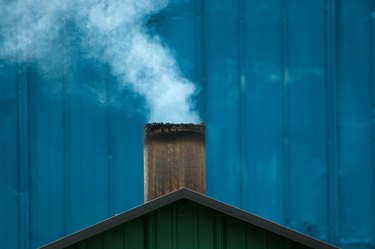Things You'll Need
Chimney brushes
Small wire brush
Rope
Weight (15 to 20 pounds)
Chemical chimney cleaner
Drop cloth
Masking tape
Flash light
Air mask
Protective gloves
Slip-resistant footwear
Vacuum

Creosote is a brown or black tar-like material that sticks to a chimney's walls, flue and hearth. Over time, creosote can build up and become a fire hazard. Cleaning your chimney at least once a year helps remove creosote and prevent sudden fires from breaking out. When cleaning your chimney, it is important to remove as much creosote as possible using a chimney brush. Chemical cleaning products, such as creosote sweeping logs, help prevent creosote buildup after a proper cleaning.
Step 1
Purchase a chimney brush sized to fit the chimney flue. Brushes can be found in most hardware or home improvement stores. Consult the chimney manufacturer's manual to determine the flue size. Additional equipment needed is a weight between 15 and 20 pounds and rope. The weight should fit down the flue without cracking chimney tiles.
Video of the Day
Step 2
Seal off the fireplace using a drop cloth and masking tape. Close the damper to trap creosote and soot that falls. Shut all doors and windows to reduce draft while cleaning. Wear protective gloves and an air mask while cleaning to prevent injury.
Step 3
Go up to the roof. Attach the chimney brush and weight to the end of the rope. The weight helps move the brush down the chimney during cleaning. Move the brush up and down on each side of the chimney. Lower the rope a little more as you do this to remove creosote. Use a flashlight to make sure the chimney is clean. Return to the fireplace to clean up fallen creosote and soot.
Step 4
Remove the drop cloth and place it underneath the damper. Open or remove the damper slowly. Use a vacuum to remove creosote and soot from the hearth and surrounding areas. Wear protective gloves and an air mask while cleaning.
Step 5
Use a chemical cleaner, such as a chimney sweeping log or liquid, to reduce creosote buildup after cleaning. Chemicals coat chimney walls with an acid that breaks up creosote particles. Chemical cleaners remove small amounts of creosote and are not intended as a substitute for regular chimney cleaning. Chimney logs and other chemical cleaners can be found in most home improvement and grocery stores.
Tip
Fiberglass or metal chimney cleaning rods used by many professional chimney sweeps are available to consumers as an alternative to using a rope. Clean your chimney at least once a year to prevent heavy creosote buildup. Conduct weekly checks to determine how quickly creosote forms on chimney walls. Clean your chimney more often, depending upon how often you use it.
Warning
Hire a professional chimney sweep if you cannot clean your chimney properly. Heavy creosote buildup can cause a house fire or pollute the air, which can cause illness.
Video of the Day